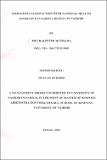| dc.description.abstract | The case for National Health Insurance satisfaction is considered in the light of the fact that only a small percentage ofthe Kenyan population is employed in the formal sector and cou Id be covered at first. Ostroff, (200 I) acknowledges that a larger percent of employers, outside government, spend on average 11% of payroll on health care for their employees. This demonstrates their lack of satisfaction with the National Health Insurance offered by the government health plans. Nevertheless, those who can readily be covered by insurance are making considerable use of the more expensive health services. The government has been in most cases concerned with ensuring the safeguard and protection of po Iicyho Ider's interests by ensuring that the insurers and schemes are financially solvent and that policy holders are not exposed to loss by underwriters by being not able to meet their obligations, but not to create the atmosphere for the growth of the industry and encourage it to respond to the prevailing needs of the society in general. The objective of the study was to establish the employees' satisfaction levels with National Health Insurance in Sarova hotels in Nairobi. The research design used in this study was the case study design. Case studies involve collection of empirical data generally from one or a small numbers of cases. It usually provides rich details about those cases, of a predominantly qualitative nature. The population comprised employees of The New Stanley and The Panafric Hotels in Nairobi which were the only hotels under Sarova chain of hotels in Nairobi County. Simple random sampling technique was used to select respondents. The data was collected through a structured questionnaire administered on a drop and pick basis which had both open and close-ended questions. Descriptive statistics data analysis was done by use of measures of central tendency which included frequencies, means and percentages. Qualitative data was analyzed by comparing responses and merging those which were alike usually in a textual or narrative form. The information was presented in tables and charts. | en_US |

